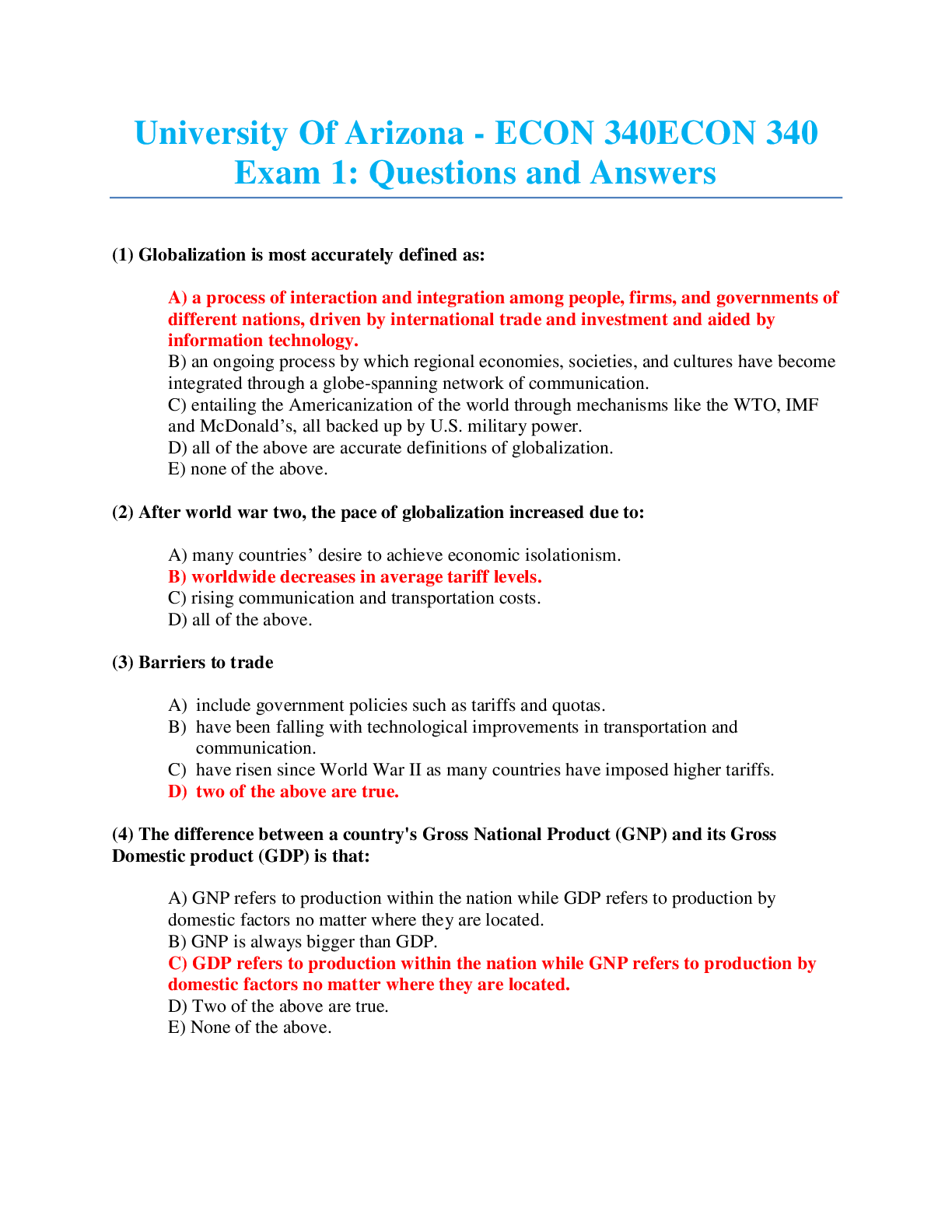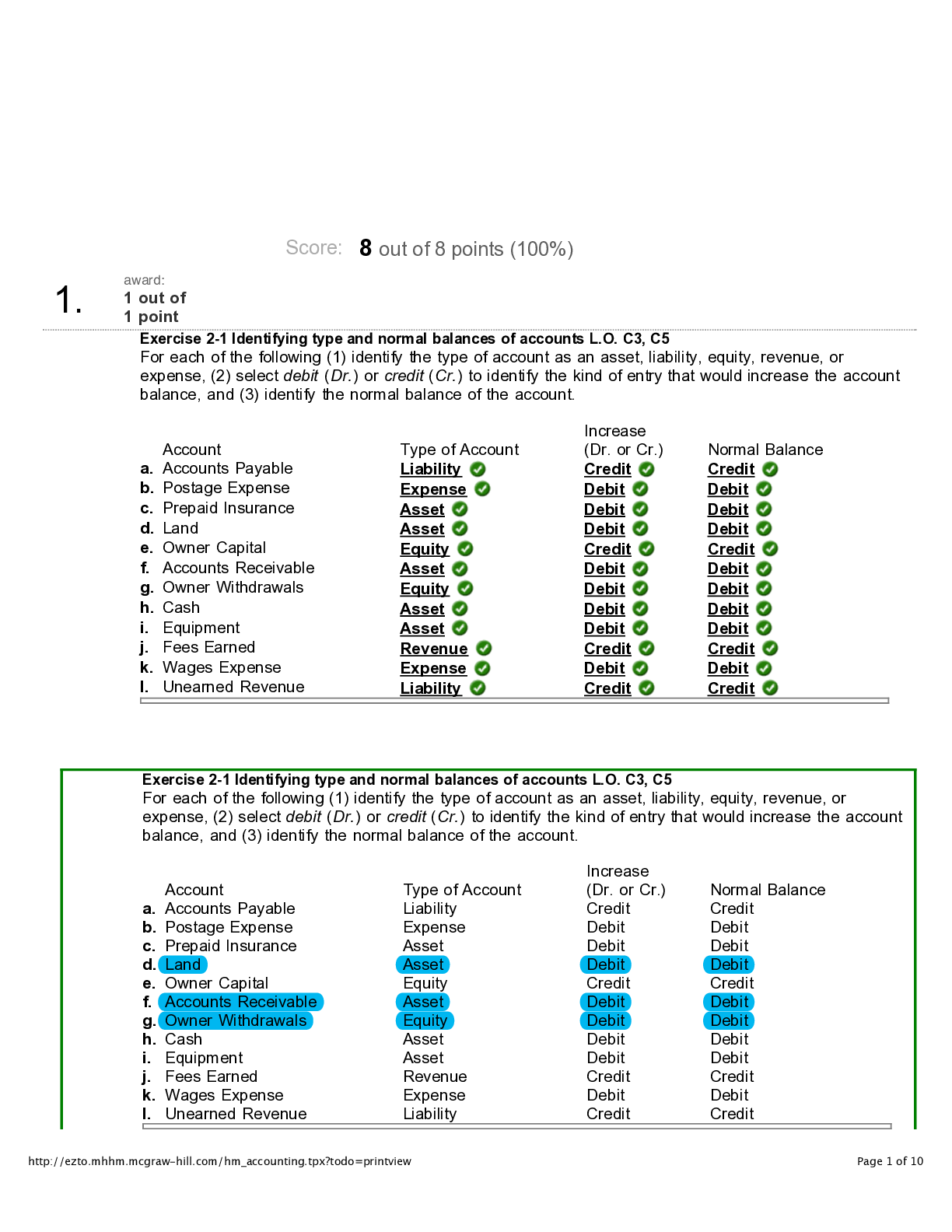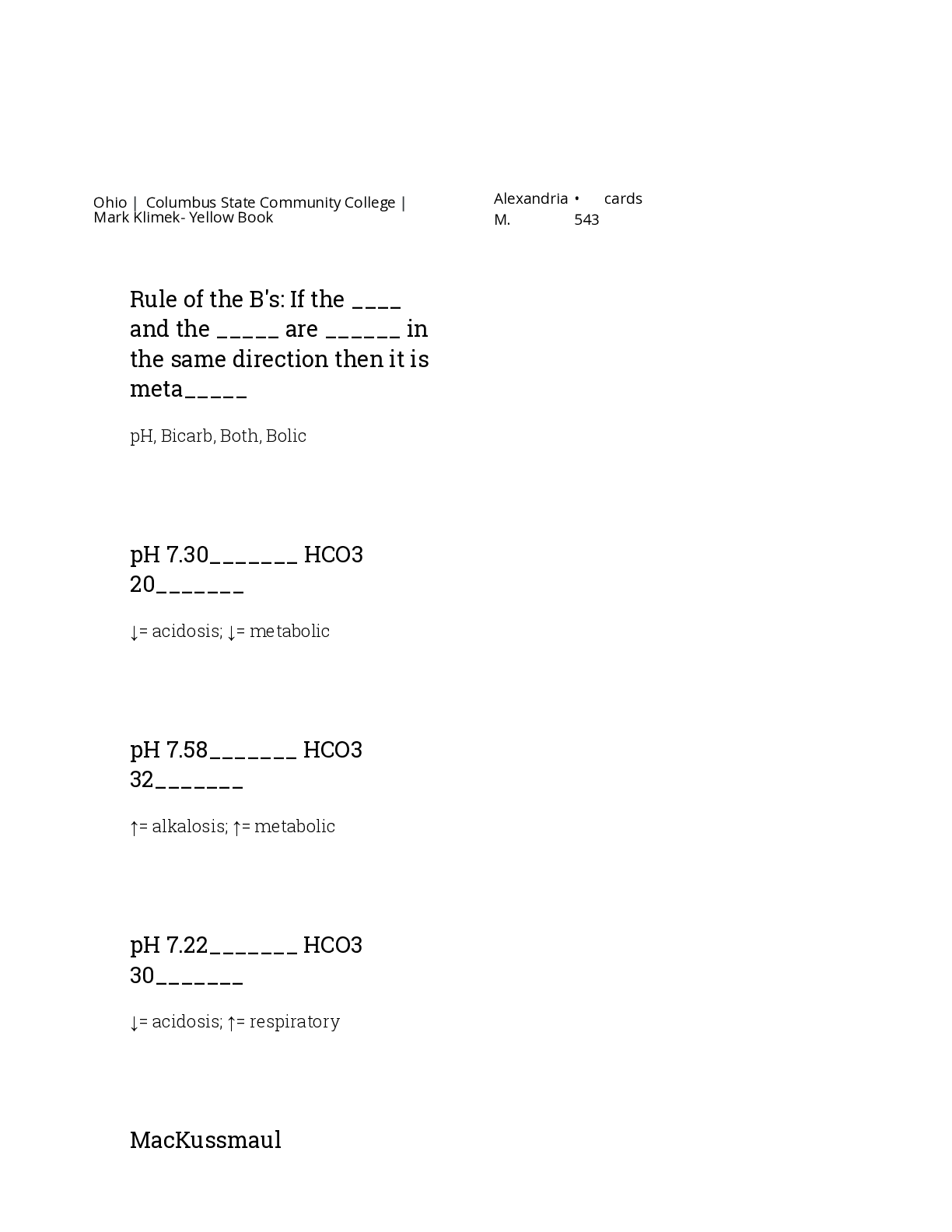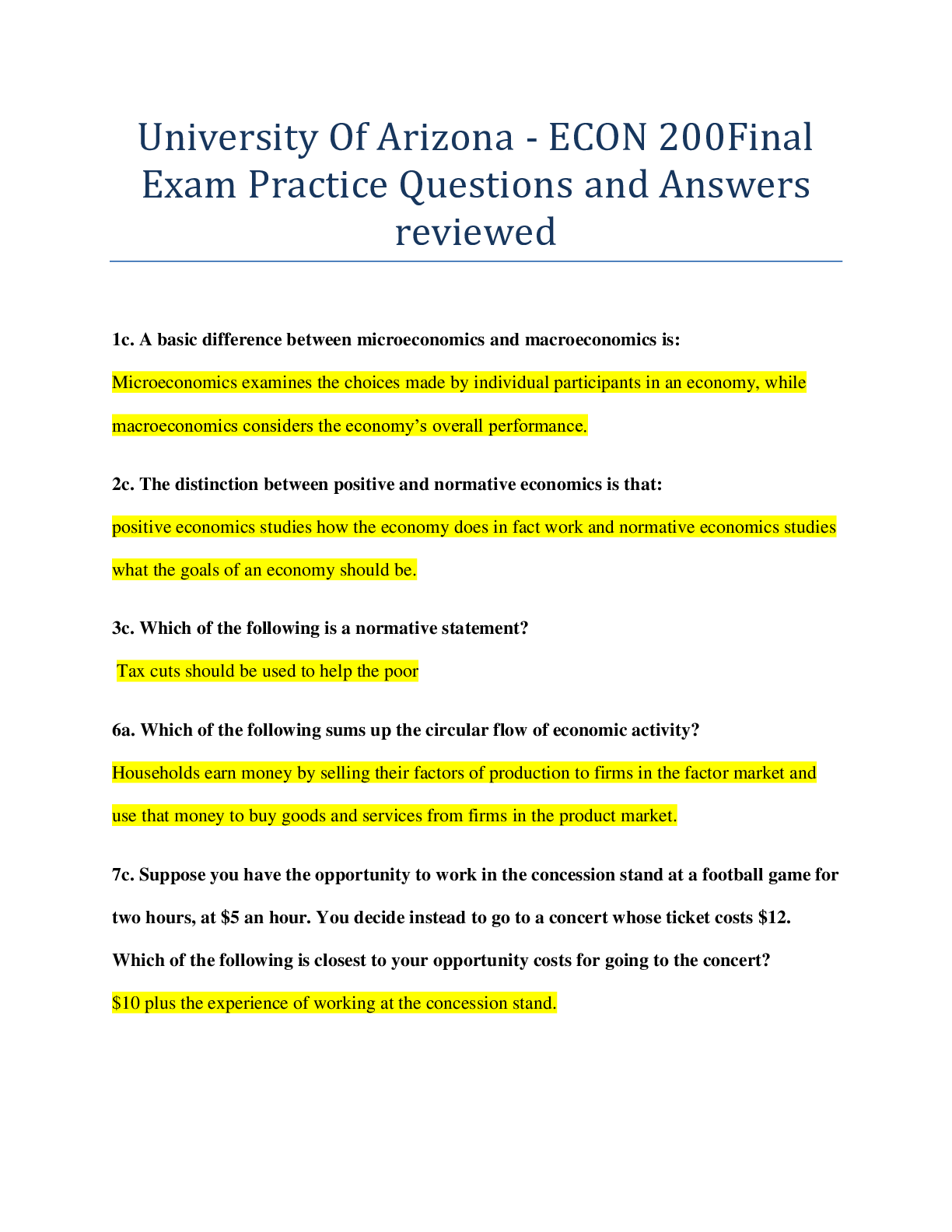Economics > QUESTIONS & ANSWERS > University Of Arizona - ECON 340ECON 340 Exam 1: Questions and Answers. Marked and Graded (All)
University Of Arizona - ECON 340ECON 340 Exam 1: Questions and Answers. Marked and Graded
Document Content and Description Below
(1) Globalization is most accurately defined as: A) a process of interaction and integration among people, firms, and governments of different nations, driven by international trade and investment ... and aided by information technology. B) an ongoing process by which regional economies, societies, and cultures have become integrated through a globe-spanning network of communication. C) entailing the Americanization of the world through mechanisms like the WTO, IMF and McDonald’s, all backed up by U.S. military power. D) all of the above are accurate definitions of globalization. E) none of the above. (2) After world war two, the pace of globalization increased due to: A) many countries’ desire to achieve economic isolationism. B) worldwide decreases in average tariff levels. C) rising communication and transportation costs. D) all of the above. (3) Barriers to trade A) include government policies such as tariffs and quotas. B) have been falling with technological improvements in transportation and communication. C) have risen since World War II as many countries have imposed higher tariffs. D) two of the above are true. (4) The difference between a country's Gross National Product (GNP) and its Gross Domestic product (GDP) is that: A) GNP refers to production within the nation while GDP refers to production by domestic factors no matter where they are located. B) GNP is always bigger than GDP. C) GDP refers to production within the nation while GNP refers to production by domestic factors no matter where they are located. D) Two of the above are true. E) None of the above. (5) Which of the following is true? A) Much of the trade of the European Union (EU) countries is with EU countries. B) Industrialized countries tend to trade relatively little with each other and largely with developing countries. C) Developing countries in Africa and South America tend to trade the most and largely with themselves. D) All of the above are true. (6) Which of the following is included in Germany's GDP? i. BMWs produced in a German owned factory in South Carolina ii. The value of the stocks sold on the German stock exchange, the Frankfurt Stock Exchange iii. China dishes produced by the English owned Wedgewood Company at a factory in Germany A) i and iii B) ii only C) iii only D) i and ii E) None of the above. (7) In 2012, Australia exported goods and services worth $1.84 trillion and imported goods and services worth $2.52 trillion. That resulted in a trade deficit of $0.68 trillion. In the same year, Australian Gross Domestic Product equaled $14.61 trillion. The index of openness for Australia in 2012 is _________. This indicates that Australia is relatively ________ to trade. A) 12.59 ; closed B) 12.59 ; open C) 17.24 ; open D) 17.24 ; closed E) None of the answers. (8) ________ analysis by economists refers to the attempt to answer questions such as what are the effects of a tax on production and consumption decisions. A) Positive B) Negative C) Normative D) Investigative (9) ________ analysis by economists refers to the attempt to answer questions such as should a tax be imposed. A) Positive B) Negative C) Normative D) Investigative (10) If individuals have money illusion then they: A) Think that money is worthless. B) Ignore the effects on their income or wealth of some price changes in the economy. C) They base their production and consumption decisions on relative rather than absolute prices. D) Both B and C. E) None of the above. Answer the questions below based on the following diagram. (11) The relative price of T (in terms of S) is: A) 2. B) 1/2. C) 500. D) 1000. E) None of the above. (12) If the relative price of S were to increase, then the price line would: A) Shift out in a parallel fashion. B) Shift in in a parallel fashion. C) Become steeper. D) Become flatter. (13) In autarky, when a community maximizes its standard of living, its consumption point is: A) Below the production possibility frontier. B) On the production possibility frontier. C) Above the production possibility frontier. D) Can’t tell without more information. Answer the question below based on the following diagram. (14) Which of the following is true? A) The relative price of S is higher at G than at D. B) The relative price of T is higher at C than at F. C) A move from D to C would raise community satisfaction. D) Two of the above are true. (15) In autarky equilibrium, the relative price is given by the slope of the production possibility frontier at point A) D. B) E. C) F. D) G E) Can't answer without more information. (16) If the autarky price of S (in terms of T) were lower in country A than in country B, A) Country A has a comparative advantage in S. B) Country B has a comparative advantage in T. C) Country A has a comparative disadvantage in T. D) All of the above. E) Both A & B. (17) If the relative price of S in terms of T is 2 and S has a nominal price of $1, then the nominal price of T is: A) $2. B) 50 cents. C) 1/2 S. D) Need more information to answer. E) $3 (18) A diagram that shows the maximum amount of one type of good that can be produced in an economy, given the production of the other is known as: A) An indifference curve. B) The tradeoff schedule. C) The production possibility frontier. D) The balance of trade. E) The Laffer curve. (19) Suppose that country A produces two goods under conditions of constant opportunity costs. Given its resources, the maximum C that it can make is 400 units, and the opportunity cost of making T is 2 units of C given up. What is the maximum amount of T that country A can produce? A) 800 T B) 200 T C) 2 T D) 1/2 T (20) In a production possibilities frontier graph, the cost of producing more units of a good is measured by the: A) Dollar value of the resources used to produce the good. B) Amount of the other good or service that must be forgone. C) Dollar value of the additional output. D) All of the above answers are correct. (21) If the relative price of Chemicals in terms of Textiles is 4 and Chemicals have a nominal price of $1, then the nominal price of Textiles is A) $4. B) 1/4 of a Chemical. C) 3 Chemicals D) 25 cents. (22) A country produces 2 goods: C and T. Assume this country is at point “A” on its increasing opportunity cost PPF where the slope of the PPF is flatter (more horizontal) than the slope of the CIC touching that same point. a. TRUE or FALSE? The standard of living would rise if the country moved away from production point “A”, down along the PPF to another point called “B”. Demonstrate GRAPHICALLY using the axes shown below. Place Textiles on the vertical axis of your graph and Chemicals on the horizontal axis. Make sure you label the axes, the PPF, the CICs, point A and point B. Briefly explain your result Answer: True. Moving from A to B increases utility, so the standard of living would rise. (23) The HO theorem states that a country will have comparative advantage in the good whose production is relatively intensive in the ________ with which the country is relatively abundant. A) Tastes B) Technology C) Factor D) Opportunity costs E) None of the above Answer the questions below based on the following diagram of a country that is in international trade equilibrium. (24) Which point denotes the equilibrium consumption? H (25) Which point denotes the equilibrium production? F (26) Which good is this country importing? Tomato (27) This country has comparative advantage in which good? Cheese (28) If Tomato is labor intensive then according to the HO theory, this country should be ________ abundant. A) Capital B) Labor C) Both capital and labor D) Can't tell without more information E) None of the above. (29) According to the Rybczynski theorem, at constant world prices, if a country experiences a gain in its capital stock it will produce: A) More of the capital intensive good and less of the labor intensive good. B) More of both goods. C) Less of the capital intensive good and more of the labor intensive good. D) Less of both goods. E) Can’t tell without more information. (30) Let Kj and Lj denote the capital and labor stocks of country j (j = A,B), then country A is said to be capital abundant relative to country B if A) KA > KB. B) KA/LA > KB/LB. C) LA < LB. D) All of the above. E) None of the above. (31) The HO model assumes that ________ are identical between countries. A) Tastes B) Technology sets C) Factor endowments D) Both A and B E) A, B and C (32) Suppose that there are two factors, capital and land, and that the United States is relatively capital abundant while Canada is relatively land abundant. According to the HO model: A) Canadian landowners should support Canada-U.S. free trade. B) Canadian capital owners should oppose Canada-U.S. free trade. C) U.S. capital owners should support Canada-U.S. free trade. D) All of the above. E) None of the above. Refer to the table below to answer the questions below. Assume that only two countries, A and B, exist. According to the Heckscher-Ohlin Theory: (33) Which country is relatively capital abundant? B (34) Which country is relatively labor abundant? A (35) If good S is capital intensive, which country will have a comparative advantage in the production of good S? Why? Answer: B because of HO Theorem America is capital abundant; Australia is land abundant. Computer production is capital intensive relative to wheat. (36) Which country has comparative advantage in computers? America (37) Which country imports wheat? America (38) Which factor in Australia will have an increase in its price with free trade? Why? Land. Since Australia is land abundant, it has comparative advantage in producing wheat. Therefore, Australia will export wheat & the price of its abundant factor (land), will rise. (39) Draw a graph for each country using the HO model (make sure you carefully label everything on your graph!) Show the autarky equilibria and show potential free trade equilibria on each graph. Place computers on the vertical axis & wheat on the horizontal axis. (40) Find and label the imports and exports for each graph. Which factors of production gain and which factors of production lose when trade arises between these two countries? Answer: Using the Stolper Samuelson Theorem, in America, capital owners (the abundant factor) gain from trade, while land owners (the scarce factor) loses from trade. In Australia, land owners (the abundant factor) gains from trade, while capital owners (the scarce factor) lose from trade. (41) Describe the controversy surrounding the HO model and the widening of the American income gap. Answer: Over the past three decades, real wages in America paid to blue collar workers have only risen slightly whereas real wages paid to college graduates have risen significantly. Many pundits claim that this income gap has been widening because of international trade, particularly as the U.S. has increased trade with developing countries such as China. The HO model predicts that low-skilled wages should fall towards wage rates paid in developing countries. Some economists have suggested that it is the rapid pace of technological change that has reduced the demand for low-skilled workers, leading to the reduced wages and employment levels in this sector. Other economists, such as Paul Krugman, suggest that trade is increasingly more responsible for expanding the income gap. [Show More]
Last updated: 2 years ago
Preview 1 out of 10 pages

Buy this document to get the full access instantly
Instant Download Access after purchase
Buy NowInstant download
We Accept:

Reviews( 0 )
$15.00
Can't find what you want? Try our AI powered Search
Document information
Connected school, study & course
About the document
Uploaded On
May 04, 2020
Number of pages
10
Written in
Additional information
This document has been written for:
Uploaded
May 04, 2020
Downloads
0
Views
100


.png)
.png)
.png)
.png)
.png)
.png)
.png)












